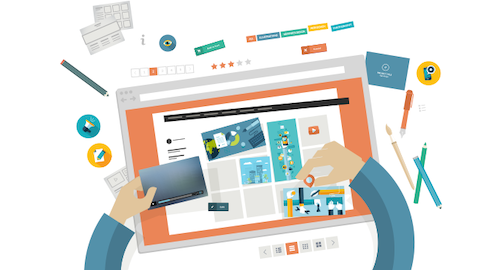Taking into account that web design has become an important topic on which experts delve more and more, it is natural to find theories, concepts and terms that, less than a decade ago, we may not have heard.
However, in the fast-paced world of online interconnectivity and all that this represents for society, we can affirm that those who do not have a website basically do not exist, and it is also essential to understand and handle all the concepts which we face in digital environments on a daily basis.

Nowadays, UX and UI are two often heard concepts when it comes to web design good practices. Web design has become one of the most relevant pillars for a webpage good performance, while good websites are essential for companies´ marketing strategies. However, web design is not only about making the site look beautiful, since the true focus of web page design lies in the importance of having a space where the user feels comfortable and achieves his goal quickly and intuitively. In other words, if a website doesn´t help the final user, it is worthless.
Here is where UX and UI concepts appear, which, although many people tend to use both terms as synonyms and believe that these concepts fulfill the same function, they are different elements.
What is UX?
UX (User Experience) is about everything that the user perceives during his interaction with the website. In general terms, we can say that a good user experience happens when a website design is useful, usable and attractive, having an important effect on customer-brand satisfaction and connection.
In other words, to establish a good UX it is essential to focus on the end user´s needs and align them with the company´s objective. This means that, apart from the common functions of a UX Designer (market evaluation, customer research, KPI analysis and data structuring), it is vital that they have general understanding about digital product development, psychology, marketing and communication, in addition to a brilliant aesthetic sense, which is essential in web design.
To exemplify, imagine that we come to a page whose web design is beautiful and offers what we are looking for, but it has an extensive and difficult to understand process. This can make us leave the site, resulting in a potential customer loss.
It is at this point where an expert in web design and user experience must act as a psychologist to detect the causes of the low conversion rate, as well as help establish a solution from different prototypes (trial and error) until giving on the spot. In this way, site managers will be able to see the increase in visits, on-site duration and conversions.
What is UI?
The UI (User Interface) concept covers the visual elements that allow the user to interact with a web page in an appropriate way. That is, the user interface is the result of the union between the information architecture (texts), the visual elements (images, colors, etc.) and the interaction patterns (bars, buttons, calls to action, etc. .)
With this we can understand that, within web page design, a good UI is an instrument of great value to achieve a better UX, but we cannot depend solely on it, since the user experience depends on a broader spectrum of elements.
A UI Designer must focus its work, therefore, so that the design of the web page and its interface go according to the user’s experience. It is also crucial that you can create interactive elements, as well as make them attractive and functional on all types of devices.
A good UI is a valuable instrument to achieve a better UX, but we cannot rely solely on it. So, when we talk about user experience (UX), we are referring to the way the client interacts with the website, while the user interface (UI) is about the set of visual elements such as colors, textures, images and forms that not only offer a more attractive web design, but also easier to understand.
Therefore, if you are focusing your marketing efforts and resources through a digital channel, it is essential that you know and correctly apply these concepts.

